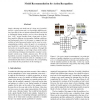Free Online Productivity Tools
i2Speak
i2Symbol
i2OCR
iTex2Img
iWeb2Print
iWeb2Shot
i2Type
iPdf2Split
iPdf2Merge
i2Bopomofo
i2Arabic
i2Style
i2Image
i2PDF
iLatex2Rtf
Sci2ools
CVPR
2012
IEEE
2012
IEEE
Model recommendation for action recognition
Simply choosing one model out of a large set of possibilities for a given vision task is a surprisingly difficult problem, especially if there is limited evaluation data with which to distinguish among models, such as when choosing the best “walk” action classifier from a large pool of classifiers tuned for different viewing angles, lighting conditions, and background clutter. In this paper we suggest that this problem of selecting a good model can be recast as a recommendation problem, where the goal is to recommend a good model for a particular task based on how well a limited probe set of models appears to perform. Through this conceptual remapping, we can bring to bear all the collaborative filtering techniques developed for consumer recommender systems (e.g., Netflix, Amazon.com). We test this hypothesis on action recognition, and find that even when every model has been directly rated on a training set, recommendation finds better selections for the corresponding test...
| Added | 28 Sep 2012 |
| Updated | 28 Sep 2012 |
| Type | Journal |
| Year | 2012 |
| Where | CVPR |
| Authors | Pyry Matikainen, Rahul Sukthankar, Martial Hebert |
Comments (0)

